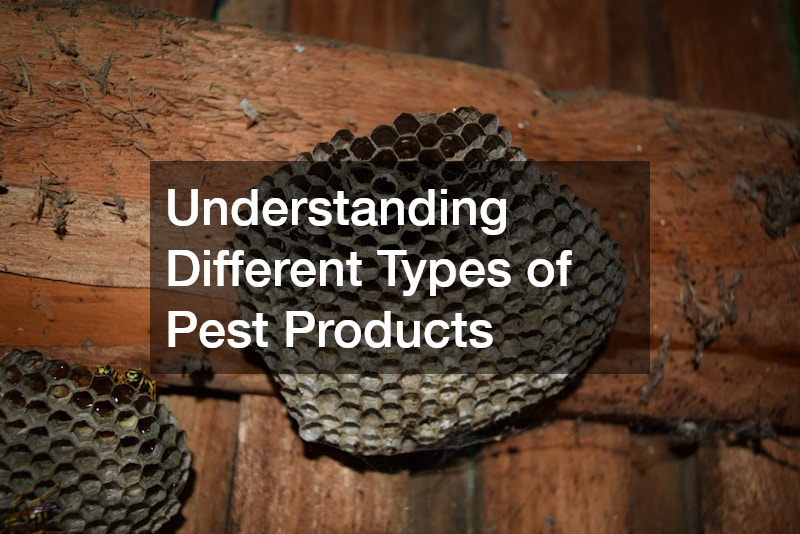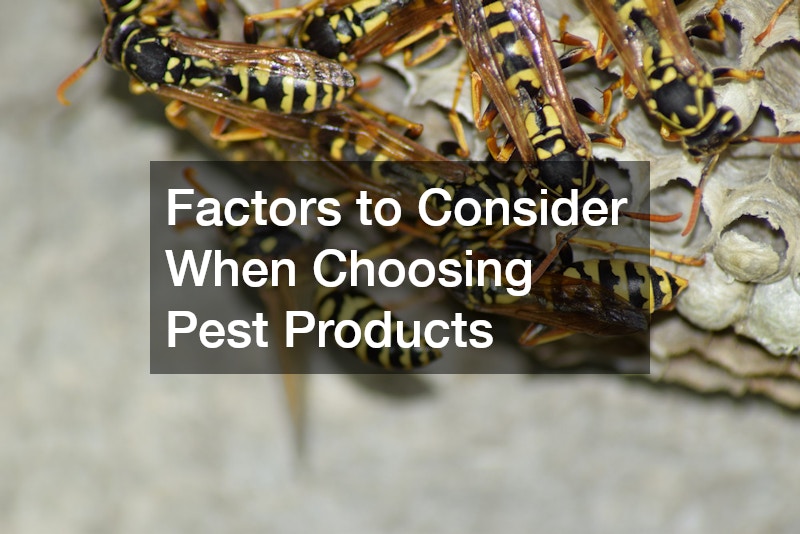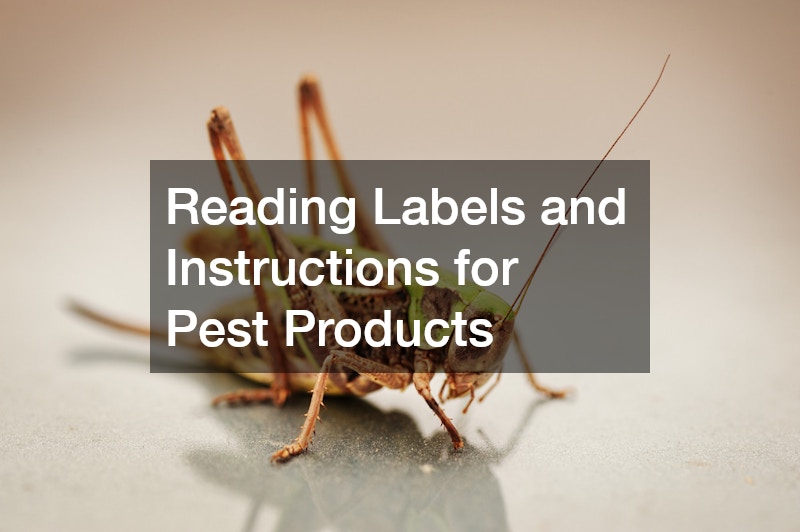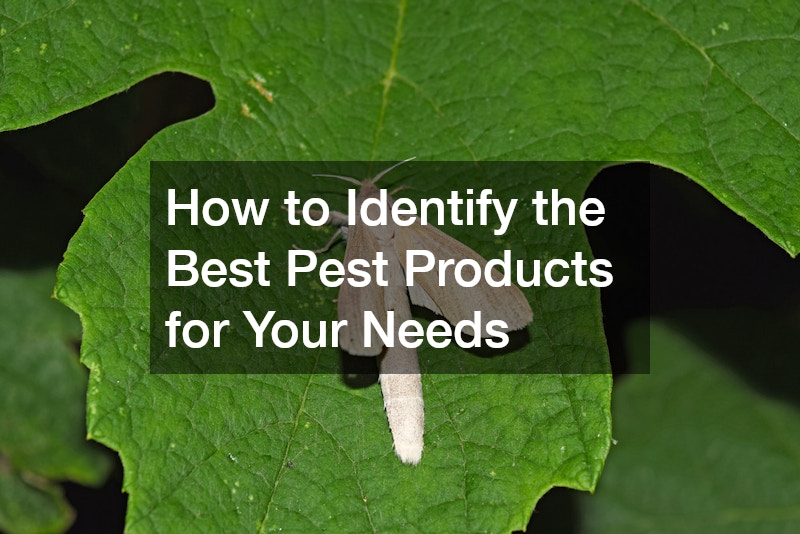Dealing with Pests In Your Home
When dealing with pests, finding the right pest products can feel overwhelming. With so many options available, it’s important to choose the products that are most effective for your specific needs. The right pest control solution can help protect your home and surroundings, while the wrong product may be ineffective or even harmful. Pest products come in a variety of forms, from sprays and traps to organic solutions, and knowing how to identify the best one involves a mix of research and understanding. By carefully evaluating the different types of products on the market and how they fit into your lifestyle, you can ensure that you’re making the best choice for long-term pest control success.

Understanding Different Types of Pest Products
There are several types of pest products available, each designed to target specific pest issues in varying ways. Broadly speaking, pest products can include insecticides, repellents, baits, and traps. Insecticides and repellents often focus on immediate elimination or prevention of pests, while baits and traps are more targeted solutions designed for long-term control. The products can also be classified as either chemical or organic, with chemical products generally providing faster results and organic solutions offering a safer, eco-friendly approach. Understanding these categories helps consumers decide which product will best serve their immediate pest control needs.
When addressing pests such as bees, for example, you may need a specialized solution like a bee removal service. While general pest products might address ants or roaches, bees require specific methods due to their importance in pollination and their potential danger when nests are located near homes. Products tailored for bee removal typically avoid harmful chemicals and focus on relocating the hive safely rather than exterminating it.
Evaluating Pest Product Effectiveness
Effectiveness is one of the most important factors to consider when choosing pest products. A product’s ability to eliminate or prevent pests hinges on its active ingredients, how it is applied, and how consistently it’s used. Chemical-based products tend to work quickly, killing pests on contact or through ingestion, while natural or organic products often require more time and patience to see results. Additionally, a product’s effectiveness can vary depending on environmental factors such as humidity, the type of surfaces in your home, and the particular pest you are targeting. Ensuring that you follow the manufacturer’s instructions carefully can maximize the product’s potential for success.
For homeowners working with a home improvement contractor on renovation projects, selecting effective pest products becomes even more crucial. During construction, pests may be disturbed or drawn to your property, requiring effective intervention. Products designed for pre-construction use, such as termite treatments or rodent repellents, can protect against infestations before they begin.

Factors to Consider When Choosing Pest Products
When choosing pest products, it’s essential to consider various factors to ensure you select the most suitable option for your needs. One of the first considerations is the type of pest you’re dealing with, as different pests require different approaches. For instance, a product designed to control insects may not be effective against rodents, and vice versa. You’ll also want to think about the area in which the product will be used—indoor versus outdoor products often differ in strength and formulation. Additionally, factors such as safety, especially around children and pets, as well as the environmental impact, should play a role in your decision. Some pest products are highly effective but may pose risks if not handled properly.
For homeowners with residential fencing, outdoor pest control solutions often require additional consideration. Products that are effective inside the home may not work as well in outdoor environments, especially around fences where pests like termites or ants can cause structural damage. In this case, pest products designed for outdoor use, such as barriers or repellents, can help protect fencing and other outdoor structures.
Comparing Natural vs. Chemical Pest Solutions
The debate between natural and chemical pest solutions is one that many homeowners face. Chemical pest products are typically faster-acting and can provide immediate relief from infestations. These products often contain synthetic chemicals designed to kill pests quickly, which is ideal in urgent situations where pests pose a threat to health or property. However, chemical products may also carry risks, especially if used improperly, as they can be toxic to humans, pets, and the environment. Natural pest products, on the other hand, tend to use ingredients such as essential oils, diatomaceous earth, or botanical extracts. While they may take longer to work, they are generally safer and more eco-friendly, making them a preferred choice for those looking to reduce their environmental impact.
For homeowners undergoing window repairs, choosing between natural and chemical pest products is critical to maintaining a safe living environment. During repairs, windows may be exposed to the outside, making it easier for pests to enter. Chemical pest products may offer immediate protection, especially if there’s an urgent need to prevent pests from entering through temporary gaps in window structures. However, if you’re concerned about long-term exposure to chemicals inside your home, natural alternatives can be a safer option.

Identifying Safe Pest Products for Home Use
Safety is a top priority when choosing pest products for home use, particularly if you have children or pets. Some pest control products contain harsh chemicals that, while effective at eliminating pests, may pose risks if not handled properly. Reading the product labels and understanding the active ingredients is essential. Many pest products now come with safety ratings that indicate their level of toxicity. For indoor use, you may want to select products that are specifically labeled as safe for homes with pets or children. Additionally, the method of application can affect safety. For instance, baits or traps that are placed out of reach are often a safer alternative to sprays or powders that can linger in the air or on surfaces.
In homes with seamless gutters, pest control becomes even more crucial. Gutters can become a breeding ground for pests such as mosquitoes, which thrive in stagnant water. Choosing pest products that target these areas is important, but safety should not be overlooked. For example, if you’re using pest products around gutters, opt for products that are safe for outdoor use but won’t harm water systems. Non-toxic granules or mosquito dunks can be placed in gutters to kill larvae without posing a risk to the surrounding environment or to any wildlife that may come into contact with them.
Selecting Products Based on Pest Types
One of the most important factors in choosing pest products is identifying the type of pest you are dealing with. Different pests require different solutions, and using the wrong product may be ineffective or even worsen the problem. For example, insecticides designed for ants won’t necessarily work for rodents, and vice versa. Additionally, within the same category of pests, such as insects, there are products designed to target specific species, like cockroaches, termites, or mosquitoes. Understanding the pest’s behavior, life cycle, and habitat can help in selecting the most appropriate and effective pest product.
For homeowners undergoing roof replacement, selecting pest products becomes even more vital, as the process can disturb pests that live in or around the roof. Rodents, birds, or even insects may have nested in the roof structure, and removing the roof may drive them into other parts of the home. Pest products designed for roof areas, such as repellents for rodents or bird spikes, can be useful in preventing new infestations once the replacement is complete.

Reading Labels and Instructions for Pest Products
When it comes to pest products, reading and understanding labels is critical for safe and effective use. Pest product labels provide important information, including the active ingredients, the pests they are designed to target, and instructions on how to apply the product. They also include safety warnings that inform users about any potential risks to humans, pets, or the environment. Failing to follow the label’s instructions could result in improper application, leading to ineffective pest control or even health hazards. Additionally, the label will outline how often the product should be reapplied for best results. Understanding this information ensures that you’re using the product correctly and getting the most value from your purchase.
For florists, carefully reading labels is essential when selecting pest products to protect plants and flowers. Certain chemicals may be harmful to plants, especially delicate species that florists often work with. Organic pest products or those specifically designed for use around flowers are often the safest bet. Florists need to ensure that pest products will not damage their blooms or leave harmful residues that could affect plant health.
Considering Eco-Friendly Pest Control Options
Eco-friendly pest control options have gained popularity in recent years as more people become conscious of their environmental impact. These products typically use natural ingredients like essential oils or plant-based compounds to deter or eliminate pests. Eco-friendly pest products are designed to minimize harm to the environment, people, and pets, while still providing effective pest control. Although they may take longer to work than chemical alternatives, these products are often safer for use in sensitive areas, such as kitchens or gardens.
For plumbers, eco-friendly pest control is particularly important when dealing with water systems. Harsh chemicals can contaminate water sources, making it critical to use environmentally safe pest products around plumbing installations. Whether dealing with insects or rodents, plumbers may encounter situations where pest control is necessary, especially when pests nest in or around pipes. By choosing eco-friendly options, plumbers can protect both the plumbing system and the surrounding environment from contamination.
Choosing Pest Products for Outdoor vs. Indoor Use
When selecting pest products, it’s crucial to distinguish between those meant for indoor versus outdoor use. Indoor pest products are typically designed with a focus on safety for people and pets, as they need to be applied in living spaces. These products may be less potent than outdoor solutions but are still effective when applied correctly. Outdoor pest products, on the other hand, are often stronger and formulated to withstand environmental factors such as rain, wind, and sunlight. Outdoor products might include repellents, barriers, and pesticides that are designed to cover larger areas or be more resilient against outdoor elements. Understanding these distinctions helps ensure you use the right product for your space.
When it comes to pipe installation with professionals, outdoor pest control can be particularly important, as pests often invade outdoor plumbing systems, causing blockages or structural damage. Outdoor pest products can prevent insects or rodents from entering through gaps or openings around pipes. Ensuring the correct type of product is used—whether it’s granules to keep ants away from foundations or rodent deterrents around exposed pipes—can help maintain both the functionality and integrity of plumbing installations.
Knowing When to Seek Professional Pest Control Assistance
While many pest problems can be handled with over-the-counter pest products, there are times when professional assistance is necessary. Larger infestations, complex pest issues, or pests that are resistant to standard products may require the expertise of a pest control service. Professionals have access to specialized tools and products that are often not available to consumers. Additionally, they can assess the severity of an infestation, identify potential entry points, and recommend long-term solutions to prevent future issues.
For carpet cleaner services, pest control may sometimes be needed when pests, such as fleas or carpet beetles, infest the fibers of carpets. While over-the-counter pest products can help with minor infestations, a professional carpet cleaner might be necessary to fully eliminate the problem. Carpet cleaning services can deep-clean and sanitize affected areas, making them a valuable partner in your pest control strategy.
Maintaining A Pest-Free Home
Choosing the best pest products for your needs requires careful consideration of several factors. From understanding the different types of products available to evaluating their effectiveness and safety, each decision plays a critical role in ensuring you select the right solution. Whether you’re dealing with a small, localized pest issue or a more extensive infestation, making informed decisions about pest products can save you time, money, and frustration. It’s important to consider not just the type of pest you are dealing with, but also the environment in which the product will be used and whether you prioritize eco-friendly options.
